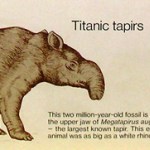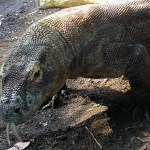mammalogy
Yet again the world is going nuts over a weird, ugly carcass that is being identified by some as an alien, as a genetic mutation 'of some sort' (duh?), as a deformed dolphin (seriously: what?), or as an unidentified 'monster' that perhaps represents a new species. I've lost track of how many emails I received yesterday about the thing. It's being dubbed the Cerro Azul Monster or Blue Stream Monster or Blue Hill Horror and was discovered at Cerro Azul, Panama. As was the case with the Montauk Monster, the animal's real identity is bloody obvious and this is no mystery.
The (almost definitely…
You may recall that we had a bit of an Andrewsarchus thing going on here back in August. As you'll know if you followed the articles in question, there is now some suggestion that Andrewsarchus was not the megawolf mesonychian once imagined, but instead a weird relative of those entelodont giant killer pigs from hell. Inspired by this suggestion, a few artists have started to re-imagineer the animal. The other day I was very happy to see the following brand-new piece of art, produced by Tet Zoo regular Jaime Chirinos of Zooartistica (image © Jaime Chirinos, used with permission)...
Jaime's…
Purely because it's semi-topical - well, it was jokingly alluded to in the brief tapir article from the other day - here's a little bit of information about the world's biggest ever tapir, Tapirus augustus Matthew & Granger, 1923, the Pleistocene Asian species formerly known as Megatapirus (it's best known from southern China, but has also been reported from Java and Vietnam. Incidentally, some authors say that it survived into the Holocene). Some people estimate that this tapir was about 3.5 m long, and 1.5 m tall at the shoulder. Wow!
Now, I bet you're thinking... what, you mean…
Dave Hone (of Archosaur Musings) kindly provided the following photo, taken in Seoul Zoo. It features a South tropical American tapir - but which one? Test your skills...
I love tapirs. But they're not always nice. In 1998 a Malayan tapir Tapirus indicus at Oklahoma Zoo bit a keeper's arm clean off, and also caused facial injuries and a punctured lung to the woman during the attack. The tapir had a two-month-old baby, and this presumably explained its aggressive behaviour. Also worth noting is that Haddad et al. (2005) described a fatal attack by a tapir on a man, though in this case the…
Time to finish with the mesonychians. Previous articles have looked at Andrewsarchus and the triisodontids, the mesonychids, and the hapalodectids. That's essentially it... though - as mentioned a few times now - Andrewsarchus doesn't seem to be a mesonychian after all. However, there are a number of other obscure Paleogene mammal groups that have been considered to be allied to (or part of) Mesonychia by some authors, and in the interests of completeness I want to look at them here.
We start with the didymoconids. This is a peculiar group of Asian mammals known from the Paleocene, Eocene…
If you've been enjoying the series on mesonychians you'll be pleased to hear that it's not completely over. There are a few groups yet to come (though, as we'll see, whether they really are mesonychians or not is controversial. 1000 Tet Zoo dollars* to whomever guesses the names of the groups I'm talking about). Anyway: you can't think awesome extinct Cenozoic mammals and not think Carl Buell. They're kind of synonymous. And, whaddayaknow, here's something incredible...
Yes, Carl has done an Andrewsarchus. Sincere thanks to Carl for allowing me to use it; I won't say much as the picture…
No time for anything substantive, but here's a montage featuring some of the stuff we've been looking at while on holiday. Some of the cats here are rather unusual: the tiger in the middle of the top row was a Siberian x Chinese hybrid.
Getting good photos of the jaguars proved not so easy (see bottom right).
We now move to another mesonychian group: Hapalodectidae. This is yet another of those obscure little groups that sounds really interesting, yet are never the subject of focus or discussion. Virtually all of the literature on them - and that's still only ten papers or so - mentions the idea that they might have been piscivorous, but I can't find any elaboration of this and would like to see some. Hapalodectidae was named by Szalay & Gould (1966) as a mesonychid 'subfamily' (following Ting & Li (1987) and others, I here refer to the group as Hapalodectidae instead of Hapalodectinae);…
After Andrewsarchus, the best known mesonychians are the mesonychids... and, as we saw previously, Andrewsarchus may not be a mesonychian anyway. Mesonychids are a mostly Eocene group that originated in the Paleocene; Mesonyx, from the Middle Eocene of North America, was the first member of the group to be named (Cope published the name in 1872), and it's still one of the most familiar mesonychians, by which I mean one of the kinds featured most frequently in the popular and semi-technical literature. Its limbs indicate a cursorial lifestyle [Charles Knight's Mesonyx shown below].
A number…
We saw in the previous article that Andrewsarchus, most 'famous' of mesonychians (even though it may well not be a member of this group), is not just a scaled-up Eocene wolf, but really something quite unusual. Indeed, it's so unusual that Szalay & Gould (1966) decided that it's worthy of its own group, Andrewsarchinae. In modern phylogenetic parlance, Andrewsarchinae is redundant, given that it's monotypic. However... here's where things become a bit more complicated...
There's more than one species of Andrewsarchus, and what of Paratriisodon?
In 1959, Chow described the new species…
The previous article was a brief, cursory introduction to the mesonychians. Time to look at things in a bit more detail...
Andrewsarchus mongoliensis is, of course, 'the' mesonychian for most people, and one might get the impression that it's a typical member of the group. In fact it's most definitely not typical, and - ironically - it's not even part of Mesonychia in the majority of recent phylogenetic studies (O'Leary 1999, O'Leary & Geisler 1999, Gatesy & O'Leary 2001, Geisler 2001, O'Leary et al. 2003, O'Leary & Gatesy 2008)... though this might be due to the fact that it's…
What the hell, I've decided to keep the ball rolling with the Paleogene mammals, and do a whole week series on mesonychians. Yes, let's deal with a group that everyone has at least heard of.
Mesonychians are an assemblage of Paleocene and Eocene mammals, best characterized (or are they?) by the superficially wolf-like carnivorous or omnivorous forms Andrewsarchus and Mesonyx [life-sized Andrewsarchus model above from here]. Why use the term 'mesonychians' and not 'mesonychids'? Answer: because there is at least some evidence linking a number of non-mesonychid taxa with Mesonychidae. Some…
Inspired by yesterday's comments, I'm very keen to get posting on the Paleogene mammals we were talking about. I mean, seriously, I've got stuff prepared on pantodonts, apatemyids, pantolestans, dinoceratans, artocyonids, mesonychians... I just do not have the time to finish it and publish it. So here's another sneak peek, which I'll discuss in due time (sorry to keep doing this, I hope you can understand).
Dinoceratans: what did they do? If you consult most sources you'll see them being depicted, and discussed, as forest-dwelling rhino analogues that had a weak, undersized and poorly…
I know, I know: these are the sorts of animals you want to find out about, but just can't. Dinoceratans (much more than just Uintatherium Uintatherium Uintatherium), mesonychians, phenacodonts and arctocyonids. And what about pantodonts, tillodonts, taeniodonts.. and so much more? I know it's cruel, but one day I'll get round to them. One day. Consider this an annoying teaser.
Artwork by Michael Long, ZdenÄk Burian and Graham Allen.
For other articles on Paleogene placental mammals see...
Homage to The Velvet Claw (part I)
Giant killer pigs from hell
Snow White and the six perissodactyls…
Welcome to the last article in my little series on Inside Nature's Giants (see part I, part II and part III first). The final, fourth episode looked at giraffes (or, specifically, Rothschild's giraffe Giraffa camelopardalis rothschildi, or G. rothschildi if you prefer). For me this was the most impressive episode; partly because they covered just about everything you could think of, and partly because I haven't seen inside a giraffe before. Graham Mitchell was on-hand as their giraffe expert (is this the same Graham Mitchell who also publishes on crocodile farming?). They showed us the…
The second episode of Inside Nature's Giants (read part I first) looked at whale anatomy: this time round, the autopsy was carried out on a Fin whale Balaenoptera physalus that had died off the coast of County Cork, southern Ireland.
Whereas the other dissections all took place in the RVC, this one was carried out in place on a beach, meaning that the weather, tides and light all intervened and spread the dissection out over two days (hence the rain spots on the image above; © Channel 4). The whole event was led by Joy Reidenberg, and toward the end of the episode she was literally standing…
Over the past few weeks, Channel 4 here in the UK screened the four-part series Inside Nature's Giants. If you're at all interested in the world of zoology you'll already - I assume - have heard quite a lot about it. I watched it religiously, and let me tell that you that it was excellent, well deserving of the Tet Zoo stamp of approval. More importantly, it was - as billed - pretty much the first time that this sort of thing had been done for television. The public face of natural history is, let's face it, behaviour, behaviour, behaviour, behaviour, ecology, conservation, conservation,…
Yesterday I did a day of work in London. Because everything finished far earlier than I was anticipating, I had time to kill so, accompanied by trusty sidekick John Conway, what else could I do but spend a few hours at ZSL's London Zoo (ZSL = Zoological Society of London)? We had a great time and saw some neat creatures: here are a few of the highlights. We start with one of the most awesome creatures on the planet...
Yes, the incredible Komodo dragon Varanus komodoensis. To be honest I'd forgotten that they have them there: I think there are also dragons at Chester Zoo, Colchester Zoo and (…
You don't hear much about dromomerycids these days, it's always protoceratids hogging all the limelight. Here's one of the more obscure forms, the derived cranioceratin dromomerycine Procranioceras skinneri from the Miocene of the USA (originally named as a member of the speciose genus Cranioceras).
All dromomerycids are North American and they were mostly a Miocene event, petering out after the Middle Miocene and disappearing during the Early Pliocene (Janis & Manning 1998, Semprebon et al. 2004). They resembled various bovids and deer in proportions and probably lifestyle: some seem to…
A few posts ago the subject of giraffes and lightning came up in the comments (go here, and scroll down to comments 7, 9 and 10).
Thanks to an aborted book project that I've mentioned once or twice (I try not to talk about it too much, it still hurts), I have voluminous files on accidental or surprising deaths. I said I have something on death by lightning and - here - I deliver. It's not much, but then, that's not much of a surprise is it?
Lightning represents a significant hazard in the natural world and animals large and small may be killed during storms. The death of elephants following…



















